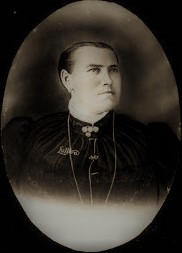 Halldóra Guðmundsdóttir lost her mother, Anna Sigurðardóttir, in childbirth when she was five years old. This was the eighth child of Guðmundur Stefánsson and Anna. Halldóra was placed in foster care with her aunt, who taught Halldóra a thing or two about midwifery. Whether her mother’s death had anything to do with her decision to become a midwife remains to be seen, but 50 years later, Halldóra had become the most well-known midwife in Duluth, Minnesota. She moved there around 1890 with her husband, Siggeir Ólafsson and their two sons. They were married in the late autumn of 1876, and the wedding was historic because in the middle of the ceremony, a big storm broke out in the west, which did not stop until four days later. Visitors were not able to get to their homes for those days, and people have talked about the Halldóra Storm ever since. In 1891, physician William Mayo, along with a group of lawyers, began working on an ordinance to register midwives in Minnesota. Halldóra was one of the first in Duluth to register and she was the first to get her clinic recognized in the city.
Halldóra Guðmundsdóttir lost her mother, Anna Sigurðardóttir, in childbirth when she was five years old. This was the eighth child of Guðmundur Stefánsson and Anna. Halldóra was placed in foster care with her aunt, who taught Halldóra a thing or two about midwifery. Whether her mother’s death had anything to do with her decision to become a midwife remains to be seen, but 50 years later, Halldóra had become the most well-known midwife in Duluth, Minnesota. She moved there around 1890 with her husband, Siggeir Ólafsson and their two sons. They were married in the late autumn of 1876, and the wedding was historic because in the middle of the ceremony, a big storm broke out in the west, which did not stop until four days later. Visitors were not able to get to their homes for those days, and people have talked about the Halldóra Storm ever since. In 1891, physician William Mayo, along with a group of lawyers, began working on an ordinance to register midwives in Minnesota. Halldóra was one of the first in Duluth to register and she was the first to get her clinic recognized in the city.
The home in Duluth
Siggeir and Halldóra lived in a huge, two-story house. They lived on the lower floor, then there were ten small rooms on the upper floor and one had a bathtub. A young, Icelandic worker, John Ardahl (Jón Árdal?) lived in a small room, back on the ground floor, and it was his job to milk the cow in the morning and then lead her out to the pasture from the house on his way to work. In the evening he came back with the cow. Many of Halldóra’s clients were poor, single mothers who paid for the service by cooking, cleaning and washing, some stayed with her for a long time after the birth. The Duluth News Tribune saw reason in 1907 to cover this remarkable Icelandic midwife, the oldest and most respected in northeastern Minnesota. The paper claimed that since she started working in the city, she had received 1100 children, 112 in the year (1907) that had just passed. Her hospital was nothing more than a slum, a hole in a dark alley, her home was both a hospital and a home for the women. She had the support of a city councilor and well-known fundraisers. Legend has it in Halldóra’s family that she never lost a child or a wife.
Based on an article in the Sunday newspaper Minneapolis Star Tribune, 4 January 2015, by Curt Brown.
English version by Thor group.
